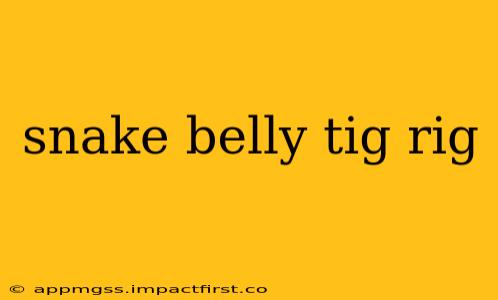The "snake belly rig" is a highly effective fishing technique, especially popular for targeting catfish, but also useful for other bottom-feeding species. Its name comes from the way the bait presents itself – resembling a snake's belly – making it incredibly enticing to predatory fish. This guide delves into the specifics of this rig, explaining its components, how to tie it, and when to use it for maximum success.
What is a Snake Belly Rig?
The snake belly rig is a simple yet effective bottom-fishing setup. It consists of a weight (typically a bullet weight or egg sinker), a swivel, a leader line, and a hook baited with your chosen offering. The key feature is how the bait is presented: the weight sits on the bottom, the leader line allows the bait to float slightly above, mimicking a wounded or vulnerable creature. This creates a natural, enticing presentation that triggers strikes.
How to Tie a Snake Belly Rig
Tying a snake belly rig is straightforward, even for beginners. Here's a step-by-step guide:
- Attach the weight: Start by attaching your chosen weight to your main fishing line. Use a Palomar knot or improved clinch knot for a secure connection. The weight size depends on the current and depth; heavier weights are needed in stronger currents.
- Add the swivel: Next, tie a swivel to the end of your main line. Swivels prevent line twist, allowing your bait to present naturally.
- Attach the leader: Attach a shorter length of leader line (around 12-18 inches) to the swivel. This leader is crucial, as it allows your bait to move freely and independently from the weight.
- Tie on your hook: Finally, tie your hook to the end of the leader line. A circle hook is generally recommended for snake belly rigs, as they are designed to hook fish in the corner of the mouth, improving fish survival rates.
What Baits Work Best with a Snake Belly Rig?
The beauty of the snake belly rig is its versatility. Many baits work well, including:
- Live bait: Worms, minnows, and crayfish are all excellent choices, particularly for catfish.
- Cut bait: Pieces of fish, chicken liver, or shrimp can also be highly effective.
- Artificial lures: Some anglers even use small plastic worms or grubs on a snake belly rig.
Experiment with different bait types to see what works best in your specific fishing location and for the target species.
What are the Advantages of Using a Snake Belly Rig?
- Simplicity: It's easy to tie and use, even for novice anglers.
- Versatility: It can be used for a variety of fish species and in various water conditions.
- Effective bait presentation: The unique presentation of the bait makes it highly attractive to fish.
- Good for bottom feeding fish: It's ideal for targeting fish that feed on the bottom, such as catfish, carp, and bullheads.
What is the Best Hook Size for a Snake Belly Rig?
The best hook size for a snake belly rig depends on the size of bait and the target fish. For smaller bait and fish, a smaller hook (size 2-6) is appropriate. For larger bait and fish, a larger hook (size 1/0 - 4/0) is recommended.
What Type of Weight Should I Use for a Snake Belly Rig?
Weight selection depends on the water conditions. In slow-moving water or shallow areas, a lighter weight (1/4 - 1/2 oz) will suffice. In faster currents or deeper water, a heavier weight (3/4 oz - 2 oz) is necessary to keep the bait on the bottom.
When is the Best Time to Use a Snake Belly Rig?
A snake belly rig is effective year-round, but is particularly successful during periods of low light, such as dawn and dusk, or at night, when fish are more active.
Conclusion
The snake belly rig is a simple, versatile, and highly effective fishing technique suitable for anglers of all skill levels. By understanding the components, tying method, and optimal bait choices, you can significantly improve your chances of a successful fishing trip. Remember to adjust your weight and hook size based on your fishing location and target species for optimal performance.
